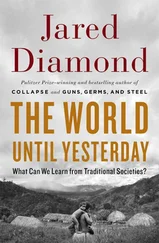Jared Diamond - Guns, Germs & Steel
Здесь есть возможность читать онлайн «Jared Diamond - Guns, Germs & Steel» весь текст электронной книги совершенно бесплатно (целиком полную версию без сокращений). В некоторых случаях можно слушать аудио, скачать через торрент в формате fb2 и присутствует краткое содержание. Жанр: 105. Описание произведения, (предисловие) а так же отзывы посетителей доступны на портале библиотеки ЛибКат.
- Название:Guns, Germs & Steel
- Автор:
- Жанр:
- Год:неизвестен
- ISBN:нет данных
- Рейтинг книги:5 / 5. Голосов: 1
-
Избранное:Добавить в избранное
- Отзывы:
-
Ваша оценка:
- 100
- 1
- 2
- 3
- 4
- 5
Guns, Germs & Steel: краткое содержание, описание и аннотация
Предлагаем к чтению аннотацию, описание, краткое содержание или предисловие (зависит от того, что написал сам автор книги «Guns, Germs & Steel»). Если вы не нашли необходимую информацию о книге — напишите в комментариях, мы постараемся отыскать её.
Guns, Germs & Steel — читать онлайн бесплатно полную книгу (весь текст) целиком
Ниже представлен текст книги, разбитый по страницам. Система сохранения места последней прочитанной страницы, позволяет с удобством читать онлайн бесплатно книгу «Guns, Germs & Steel», без необходимости каждый раз заново искать на чём Вы остановились. Поставьте закладку, и сможете в любой момент перейти на страницу, на которой закончили чтение.
Интервал:
Закладка:
Footnote: Throughout this book, dates for about the last 15,000 years will be quoted as so-called calibrated radiocarbon dates, rather than as conventional, uncalibrated radiocarbon dates. The difference between the two types of dates will be explained in Chapter 5. Calibrated dates are the ones believed to correspond more closely to actual calendar dates. Readers accustomed to uncalibrated dates will need to bear this distinction in mind whenever they find me quoting apparently erroneous dates that are older than the ones with which they are familiar. For example, the date of the Clovis archaeological horizon in North America is usually quoted as around 9000 B.C. (11,000 years ago), but I quote it instead as around 11,000 B.C. (13,000 years ago), because the date usually quoted is uncalibrated.
PROLOGUE
YALI'S QUESTION
WE ALL KNOW THAT HISTORY HAS PROCEEDED VERY DIFferently for peoples from different parts of the globe. In the 13,000 years since the end of the last Ice Age, some parts of the world developed literate industrial societies with metal tools, other parts developed only nonliterate farming societies, and still others retained societies of hunter-gatherers with stone tools. Those historical inequalities have cast long shadows on the modern world, because the literate societies with metal tools have conquered or exterminated the other societies. While those differences constitute the most basic fact of world history, the reasons for them remain uncertain and controversial. This puzzling question of their origins was posed to me 25 years ago in a simple, personal form.
In July 1972 I was walking along a beach on the tropical island of New Guinea, where as a biologist I study bird evolution. I had already heard about a remarkable local politician named Yali, who was touring the district then. By chance, Yali and I were walking in the same direction on that day, and he overtook me. We walked together for an hour, talking during the whole time.
Yali radiated charisma and energy. His eyes flashed in a mesmerizing way. He talked confidently about himself, but he also asked lots of probing questions and listened intently. Our conversation began with a subject then
14 ' PROLOGUE
on every New Guinean's mind—the rapid pace of political developments. Papua New Guinea, as Yali's nation is now called, was at that time still administered by Australia as a mandate of the United'Nations, but independence was in the air. Yali explained to me his role in getting local people to prepare for self-government.
After a while, Yali turned the conversation and began to quiz me. He had never been outside New Guinea and had not been educated beyond high school, but his curiosity was insatiable. First, he wanted to know about my work on New Guinea birds (including how much I got paid for it). I explained to him how different groups of birds had colonized New Guinea over the course of millions of years. He then asked how the ancestors of his own people had reached New Guinea over the last tens of thousands of years, and how white Europeans had colonized New Guinea within the last 200 years.
The conversation remained friendly, even though the tension between the two societies that Yali and I represented was familiar to both of us. Two centuries ago, all New Guineans were still "living in the Stone Age." That is, they still used stone tools similar to those superseded in Europe by metal tools thousands of years ago, and they dwelt in villages not organized under any centralized political authority. Whites had arrived, imposed centralized government, and brought material goods whose value New Guineans instantly recognized, ranging from steel axes, matches, and medicines to clothing, soft drinks, and umbrellas. In New Guinea all these goods were referred to collectively as "cargo."
Many of the white colonialists openly despised New Guineans as "primitive." Even the least able of New Guinea's white "masters," as they were still called in 1972, enjoyed a far higher standard of living than New Guineans, higher even than charismatic politicians like Yali. Yet Yali had quizzed lots of whites as he was then quizzing me, and I had quizzed lots of New Guineans. He and I both knew perfectly well that New Guineans are on the average at least as smart as Europeans. All those things must have been on Yali's mind when, with yet another penetrating glance of his flashing eyes, he asked me, "Why is it that you white people developed so much cargo and brought it to New Guinea, but we black people had little cargo of our own?"
It was a simple question that went to the heart of life as Yali experienced it. Yes, there still is a huge difference between the lifestyle of the average
YALTS QUESTION • 15
New Guinean and that of the average European or American. Comparable differences separate the lifestyles of other peoples of the world as well. Those huge disparities must have potent causes that one might think would be obvious.
Yet Yali's apparently simple question is a difficult one to answer. I didn't have an answer then. Professional historians still disagree about the solution; most are no longer even asking the question. In the years since Yali and I had that conversation, I have studied and written about other aspects of human evolution, history, and language. This book, written twenty-five years later, attempts to answer Yali.
although yali's question concerned only the contrasting lifestyles of New Guineans and of European whites, it can be extended to a larger set of contrasts within the modern world. Peoples of Eurasian origin, especially those still living in Europe and eastern Asia, plus those transplanted to North America, dominate the modern world in wealth and power. Other peoples, including most Africans, have thrown off European colonial domination but remain far behind in wealth and power. Still other peoples, such as the aboriginal inhabitants of Australia, the Americas, and southernmost Africa, are no longer even masters of their own lands but have been decimated, subjugated, and in some cases even exterminated by European colonialists.
Thus, questions about inequality in the modern world can be reformulated as follows. Why did wealth and power become distributed as they now are, rather than in some other way? For instance, why weren't Native Americans, Africans, and Aboriginal Australians the ones who decimated, subjugated, or exterminated Europeans and Asians?
We can easily push this question back one step. As of the year a.d. 1500, when Europe's worldwide colonial expansion was just beginning, peoples on different continents already differed greatly in technology and political organization. Much of Europe, Asia, and North Africa was the site of metal-equipped states or empires, some of them on the threshold of industrialization. Two Native American peoples, the Aztecs and the Incas, ruled over empires with stone tools. Parts of sub-Saharan Africa were divided among small states or chiefdoms with iron tools. Most other peoples—including all those of Australia and New Guinea, many Pacific
I 6 • PROLOGUE
islands, much of the Americas, and small parts of sub-Saharan Africa— lived as farming tribes or even still as hunter-gatherer bands using stone tools.
Of course, those technological and political differences as of a.d. 1500 were the immediate cause of the modern world's inequalities. Empires with steel weapons were able to conquer or exterminate tribes with weapons of stone and wood. How, though, did the world get to be the way it was in a.d. 1500?
Once again, we can easily push this question back one step further, by drawing on written histories and archaeological discoveries. Until the end of the last Ice Age, around 11,000 b.c., all peoples on all continents were still hunter-gatherers. Different rates of development on different continents, from 11,000 b.c. to a.d. 1500, were what led to the technological and political inequalities of a.d. 1500. While Aboriginal Australians and many Native Americans remained hunter-gatherers, most of Eurasia and much of the Americas and sub-Saharan Africa gradually developed agriculture, herding, metallurgy, and complex political organization. Parts of Eurasia, and one area of the Americas, independently developed writing as well. However, each of these new developments appeared earlier in Eurasia than elsewhere. For instance, the mass production of bronze tools, which was just beginning in the South American Andes in the centuries before a.d. 1500, was already established in parts of Eurasia over 4,000 years earlier. The stone technology of the Tasmanians, when first encountered by European explorers in a.d. 1642, was simpler than that prevalent in parts of Upper Paleolithic Europe tens of thousands of years earlier.
Thus, we can finally rephrase the question about the modern world's inequalities as follows: why did human development proceed at such different rates on different continents? Those disparate rates constitute history's broadest pattern and my book's subject.
While this book is thus ultimately about history and prehistory, its subject is not of just academic interest but also of overwhelming practical and political importance. The history of interactions among disparate peoples is what shaped the modern world through conquest, epidemics, and genocide. Those collisions created reverberations that have still not died down after many centuries, and that are actively continuing in some of the world's most troubled areas today.
For example, much of Africa is still struggling with its legacies from recent colonialism. In other regions—including much of Central America,
Интервал:
Закладка:
Похожие книги на «Guns, Germs & Steel»
Представляем Вашему вниманию похожие книги на «Guns, Germs & Steel» списком для выбора. Мы отобрали схожую по названию и смыслу литературу в надежде предоставить читателям больше вариантов отыскать новые, интересные, ещё непрочитанные произведения.
Обсуждение, отзывы о книге «Guns, Germs & Steel» и просто собственные мнения читателей. Оставьте ваши комментарии, напишите, что Вы думаете о произведении, его смысле или главных героях. Укажите что конкретно понравилось, а что нет, и почему Вы так считаете.










